

Andrea di Giovanni, who was probably born in Orvieto, is first documented in 1378 as an apprentice working for Ugolino di Prete Ilario in the choir of the Duomo of his native city.
He was documented in 1380, with Cola Petruccioli and Francesco di Antonio, in relation to the frescoes of a fictive choir in the tribune of the Duomo (see below). He was last documented in Orvieto in 1417, when he was commissioned to restore mosaics on the facade of the Duomo. He subsequently moved to Siena, where he was last documented in 1424.
Orvieto
Fictive choir (1380)
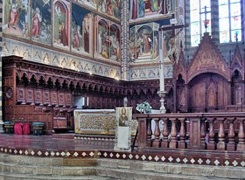
Cola Petruccioli, Francesco di Antonio and Cola Petruccioli, are documented in 1380 in relation to the frescoes of a fictive choir in the tribune of the Duomo. These frescoes, which depicted the canons seated in choir stalls, were obscured when real choir stalls were moved her from the nave in 1536, and only the upper part of them is now visible.
Annunciation (ca. 1380)
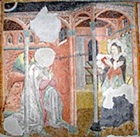
Frescoes from Santa Maria del Carmine (ca. 1394)
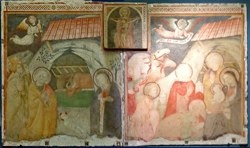
Pericle Perali (in his guide of 1919) mentions a fresco of the Annunciation to the right of the entrance of Santa Maria del Carmine, which was dated by inscription to 1394. He thought that it might be by Pietro di Puccio, but it has more recently been attributed to Andrea di Giovanni (see the reference below). [Is it still there ?] The fresco, which includes a donor portrait, probably formed part of a cycle of scenes from the early life of Christ. Three detached frescoes in the Museo dell' Opera del Duomo, which are also attributed to Andrea di Giovanni, probably formed part of this cycle. They depict:
-
✴the nativity;
-
✴the adoration of the Magi; and
-
✴the presentation at the temple (fragmentary, not illustrated here).
They were transferred to the museum from the Oratorio di Santa Maria del Carmine, and had probably been detached from the walls of the church during its remodelling in ca. 1559.
Christ in glory adored by innocents (1410)
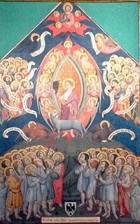
-
✴saints to the sides;
-
✴Christ the Redeemer above;
-
✴the symbols of the Evangelists above and below; and
-
✴two groups of young people looking up at the heavenly scene.
Fresco above Porta di Canonica (1412)
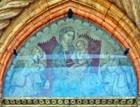
Frescoes (1411)
Buonconte Monaldeschi commissioned frescoes from Andrea di Giovanni of the Three Kings and the Coronation of the Virgin for his chapel in the duomo. They no longer survive.
Read more:
C. Fratini, “Pittura e Miniatura ad Orvieto dal XII al XIV Secolo”, in
G. della Fina and C. Fratini (Eds), “Storia di Orvieto: Medioevo”, (2007) Pisa, pp. 494-5
Return to the page on Art in: Orvieto.

